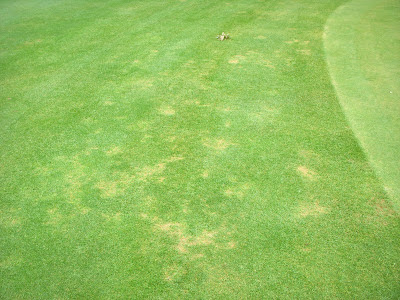Here's a direct quote from one of my turf books, "Infection by the summer patch pathogen is highly dependent on the temperature and moisture status of the soil. When soil temperatures are elevated (65-85 degrees) and there is ample soil moisture the summer patch pathogen readily infects and colonizes turf roots. As soil temperatures increase beyond 75 degrees, root growth is slow and cannot compensate for roots damaged by infection." Summer patch is most effectively treated when soil temperatures reach 65 degrees at a 3" depth for several consecutive days, and this year, our preventative applications occurred on May 22 and June 1. Unfortunately, the extreme weather, subsequent stress, and high rainfall for the last half of July caused the summer patch pathogen to rear its ugly head. This disease only affects Poa annua and Kentucky bluegrass, and once present, curative fungicide applications are not very effective. However, there are a few fungicides that are thought to help out and one was applied this week. We also solid-tine aerified the worst of the areas to promote root growth and to cool the soils with the relatively brisk nights that are being forecasted. Unfortunately, there is no silver bullet to for this disease, and it will likely linger until the temperatures are consistently lower.
The above picture from 15 approach illustrates the what summer patch looks like, and although it's unsightly, it should have minimal impact on play.
From one break (in the weather) to another, we had yet another irrigation break by an isolation valve. Each hole has a valve between the loop the feeds the entire system and the pipes that are attached to that hole's sprinklers. These valves allow us to make necessary repairs on an individual hole without depressurizing the whole irrigation system, and in the 17 years that Chad has worked here, this is the first year that any leaks have occurred in and around these isolation valves. This year, we've had three such breaks! We're not exactly sure why we've had so many, but we're speculating that the extremely dry conditions may have caused movement in the soils that resulted in the breaks. Our latest isolation valve break was by far the least complicated of the three, and we were able to fix it ourselves.
 |
| The latest break took place on hole 4, and the repaired product is pictured above. |


No comments:
Post a Comment